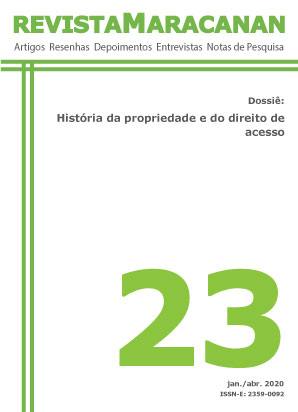Enslaved, poor and free and native peoples in the rural history of Mato Grosso: the roots and the antithesis of property by the paths and Quilombos (18th and 19th centuries)
DOI:
https://doi.org/10.12957/revmar.2020.44945Keywords:
Roças (Plantations), Enslaved, Poor and Free, Native Peoples, Mato Grosso,Abstract
For a discussion of the roads and quilombos (villages of fugitive slaves) found in Mato Grosso, in the period between the Colony and the Brazilian Empire, it is necessary to briefly reflect on the issues of the present, involving the poor of the land, to make a foray into rural history of Portuguese America, in order to overcome the tripod consecrated by the traditional historiography as the explanatory of the history of Brazil in its first three centuries: monoculture, slave labor and patroonship. In this debate, we aim to understand the importance of food production for domestic supply and the role of poor, free, enslaved and indigenous farmers in this universe. Starting from the analysis of Official Correspondence of the Province of Mato Grosso, and from sources such as Relatos Monçoeiros, we will work on some signs of the presence of roças (plantations) and roceiros (country bumpkins), in their various categories, with emphasis for some of the routes connecting the north and south of Mato Grosso, especially in the context of the monsoons. The plantations of the poor and free in the trajectory of the monsoons of the eighteenth and early nineteenth centuries, such as the cultivation of the slaves in the northern and southern quilombos of Mato Grosso and the indigenous plantations that supplied the sertanistas (frontiersmen) incursions by the south in the XIX, in the report of Defeats by Joaquim Francisco Lopes, will be themes approached for bringing traces of food production and places in which the farmers, in their diversity, lived and worked.
References
BENJAMIN, Walter. Magia e Técnica, Arte e Política. São Paulo: Brasiliense, 1987.
BORGES, Maria Celma. Roças, quilombolas e os Kayapó: uma história rural de Mato Grosso (séculos XVIII e XIX).Anais do [...]. XXVIII Simpósio Nacional de História. Lugares dos historiadores: velhos e novos desafios. Florianópolis, 2015.
CARDOSO, Ciro Flamarion. Agricultura, escravidão e capitalismo. Petrópolis, RJ: Vozes, 1979.
GIRALDIN, Odair. Cayapó e Panará. Luta e sobrevivência de um Povo Jê no Brasil Central. Campinas, SP: Ed. Unicamp, 1997.
GOMES, Flávio dos Santos. A hidra e os pântanos. Mocambos, quilombos e comunidades de fugitivos no Brasil dos séculos XVII-XIX. São Paulo: Ed. Unesp; Polis, 2005.
GOMES, Flávio dos Santos; REIS, João José. Roceiros, camponeses e garimpeiros quilombolas na escravidão e na pós-emancipação. In: STARLING, Heloisa M. Murgel; RODRIGUES, Henrique Estrada; TELLES, Marcela (orgs.). Utopias Agrárias. Belo Horizonte: Ed. UFMG, 2008.
HOLANDA, Aurélio Buarque de (org.). Novo Dicionário Aurélio. Rio de Janeiro: Nova Fronteira, 1986.
HOLANDA, Sérgio Buarque de. Monções. São Paulo: Brasiliense, 1987.
LINHARES, Maria Yeda. História do abastecimento: uma problemática em questão (1530-1918). Brasília: Binagri, 1979.
LOERA, Nashieli Rangel. Introdução: o mundo das ocupações, In: Tempo de acampamento [online]. São Paulo: Ed. UNESP, 2014.
LOPES, Joaquim Francisco. Derrotas. Campo Grande: Instituto Histórico e Geográfico de Mato Grosso do Sul, 2007.
MARTINS, José de Souza. O cativeiro da Terra. São Paulo: Hucitec, 1979.
MOTTA, Márcia Maria M. Nas fronteiras do poder: conflito e direito à terra no Brasil do século XIX. Rio de Janeiro: Vício de Leitura; Arquivo Público do Estado do Rio de Janeiro, 1998.
PEDROZA, Manoela. A roça, a farinha e a venda: produção de alimentos, mercado interno e pequenos produtores no Brasil Colonial. In: FRAGOSO, João; GOUVÊA, Maria de Fátima (orgs.). O Brasil Colonial. Vol. 3: 1720-1821. Rio de Janeiro: Civilização Brasileira, 2014.
PRADO JÚNIOR, Caio. Formação do Brasil Contemporâneo: Colônia. São Paulo: Brasiliense, 1971.
REIS, João José; SILVA, Eduardo. Negociação e conflito: a resistência negra no Brasil escravista. São Paulo: Companhia das Letras, 1989.
SCHWARTZ, Stuart. Escravos, roceiros e rebeldes. Bauru, SP: EDUSC, 2001.
SHARPE, Jim. A história vista de baixo. In: BURKE, Peter (org.). A escrita da História: novas perspectivas. São Paulo: Ed. Unesp, 1992.
TAUNAY, Afonso de E. Relatos Monçoeiros. São Paulo: Itatiaia, 1981.
VOLPATO, Luiza Rios Ricci. Quilombos em Mato Grosso: Resistência negra em área de fronteira. In: REIS, João José; GOMES, Flávio dos Santos. Liberdade por um fio: histórias dos quilombos no Brasil. São Paulo: Companhia das Letras, 2011.
Downloads
Published
How to Cite
Issue
Section
License
The copyrights of originals and translations published are automatically assigned to Revista Maracanan. The information contained in this papers are the sole responsibility of the authors.
The Copyright of the published articles belong to Revista Maracanan, with works simultaneously licensed under a Creative Commons Attribution-NonCommercial-ShareAlike 4.0 International License, which allows the sharing of work with mandatory recognition of authorship and initial publication in this journal, under the same license and for non-commercial purposes.

The Revista Maracanan is licensed with a Creative Commons Attribution-NonCommercial-ShareAlike 4.0 Internacional License.





